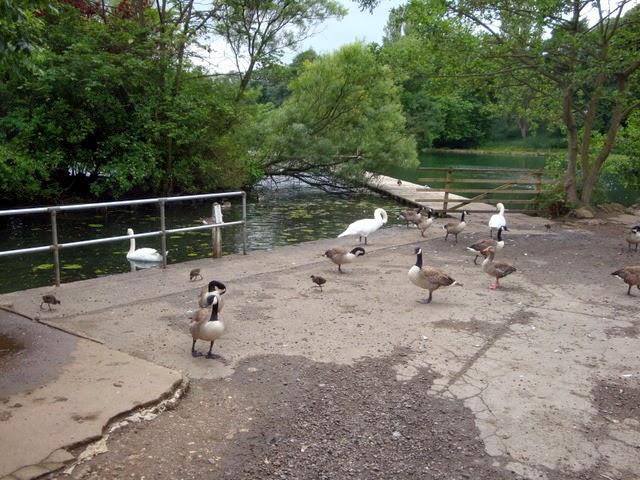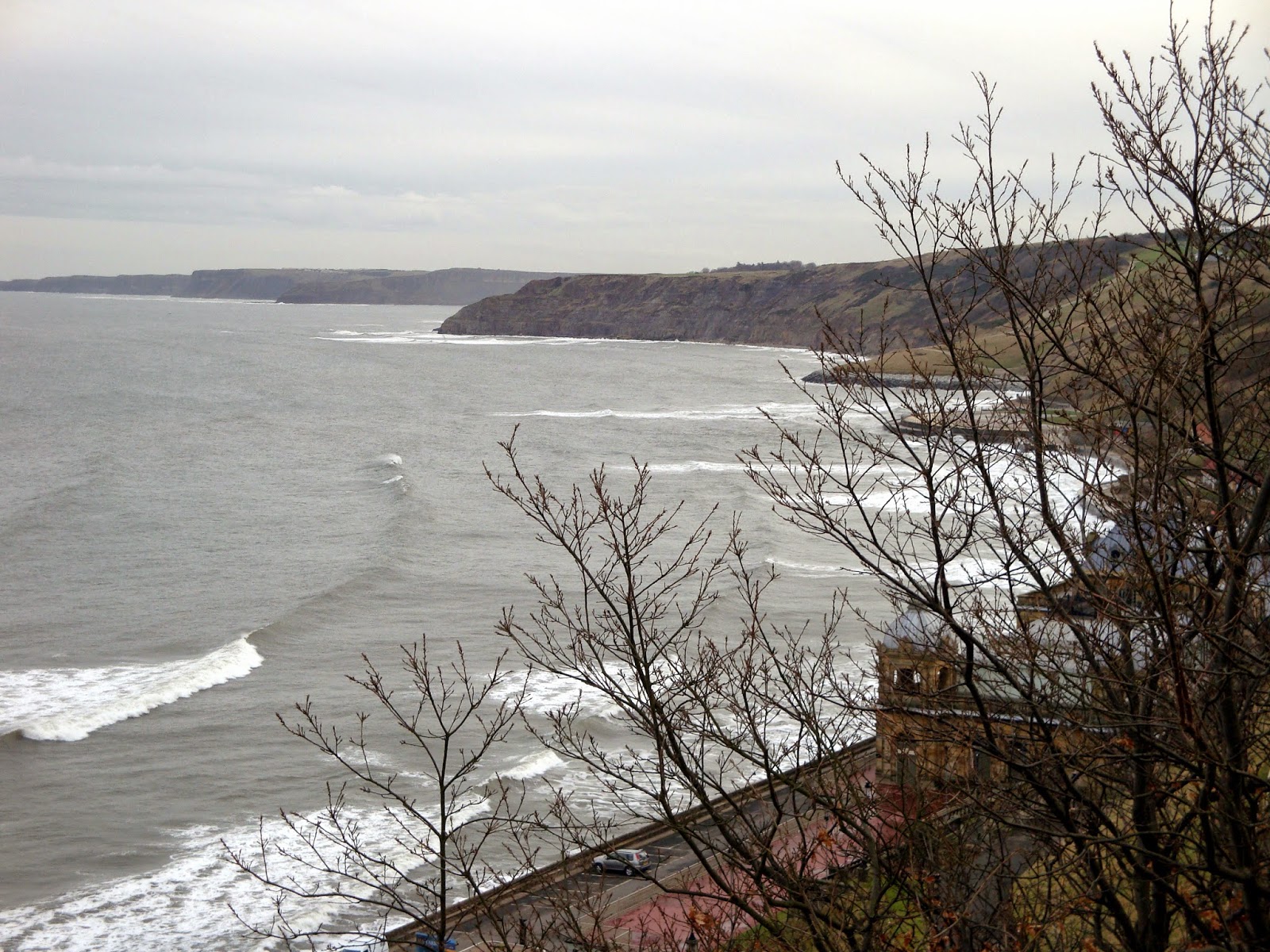My home town is Scarborough, the Queen of Watering Places and the jewel of the Yorkshire Coast. Situated in North Yorkshire, historically the North Riding of Yorkshire, between Whitby in the north and Filey in the south, the town has a population of some 50,000 people.
It is a thriving seaside resort and the harbour is still home to
a small fishing fleet.
Scarborough's south beach
The most prominent feature of the town's geography is a huge rock
promontory with its Norman Castle, pointing into the North Sea
separating the sea front into two bays.
I am starting my tour on the south side
Oliver's Mount is a large hill, 500 feet above sea level, immediately south of the town, whereon the 75 feet high war memorial and TV and radio booster mast are situated. It is believed that it is named after Oliver Cromwell, and although he never visited the town he may have had guns sited there during the Civil War. The top plateau which drops away beyond to the Vale of Pickering boasts a fine motor cycle circuit with annual racing.
Below the north side of the Mount in the Mere Valley alongside the A64 main road, is a large fresh water lake known as The Mere. Once a popular tourist area it has declined in recent years but is still popular with fishermen
and dog walkers.
The area at the northern foot of the Mount is known as South Cliff below which is a steep descent to the seaside.
There are steep cliffs to the south east towards Filey and thence to Flamborough Head, with several inaccessible bays and also Cayton Bay with its lovely beach which is accessible from the Filey Road. (see later details).
Scarborough made headlines around the world on 5th June 1992 when a landslip at the far eastern end of the South Cliff caused part of the Holbeck Hall Hotel, along with its garden, to fall into the sea.
Almost 100 years later, Smith’s
house became a popular 4 star hotel, The Holbeck Hall Hotel. Early in 1992 local residents became
alarmed when some cracks were noted some 70 metres apart on a footpath, but
they were quickly repaired and it appeared that there was no cause for
alarm. However, on June 2nd events
started to move very quickly indeed when extensive movement appeared around the
previously noted cracks and especially in the grounds of the hotel. Because the hotel , although the nearest
building to the cliff edge, was some 50 metres away, it was not taken too
seriously by the management. Then on
the evening of June 3rd the garden of the hotel had sunk four feet,
and when further movement occurred early the next morning, things became very
serious indeed. Suddenly there was rapid
movement resulting in an estimated one million tonnes of cliff material
slipping over 100 metres onto the beach below, taking 40% of the hotel with
it. The slip was 100 metres wide and
250 metres from back to toe. The
remaining parts of the hotel were subsequently demolished and fortunately no
other buildings in the area were affected.
The area of the landslip is still evident.
The road along the top of the south cliff is known as The Esplanade and tantalising views of the old town, the harbour and the south beach, are to be had along its length.
Scarborough Parks Department do an excellent job and have won awards for their landscaping and charming flower arrangements
The Esplanade ends at Holbeck, and there is a fine red brick building which became famous as the hospital in 'The Royal', a television series (2003-2011) around a 1950's hospital and a spin off from the popular Heartbeat series. The building, Red Court, with its fine views out to sea is now converted into apartments. It was bought by a business man called Alfred Shuttleworth in 1905. Directly opposite at that time was a large house, Holbeck Hurst, which obstructed Shuttleworth's views, and which he soon bought and demolished converting the land into gardens. As compensation he built a fine clock tower and subsequently presented both the extensive gardens and the clock tower to the to the town. A substantial oak shelter in the Shuttleworth Garden's has recently been restored.
This view at the rear of the property was often seen in the TV series.
Holbeck clock tower leads into Shuttleworth Gardens where there is a putting green.
Alfred Shuttleworth also presented a fine statue of Mercury which stands in the adjacent Italian Gardens which, together with Rose Gardens, were designed in the early 20th century.
 |
These level gardens are shrouded in delightful mature trees which add some stability to
the cliffs on which they stand.
Once upon a time there was a fine open air seawater bathing pool above the sea shore at the foot of these cliffs. However, due to the vagaries of English weather and its lack of use, it was filled in to make a nice seating area and further stabilise this delicate cliff.
Further along the foot of the cliff is the Spa complex where the discovery of the spa water put Scarborough firmly on the map. It was in the 17th century that a Mrs Farrer found russet coloured bitter tasting spring water bubbling out at the foot of the cliff. It was subsequently decided that this natural water probably
had medicinal qualities and soon visitors were said to be benefitting from this supposed medicine. Buildings were erected on the site and the 'spaw'
as it was then known soon became a fashionable attraction and the place to
'take the waters'.
17th century posters
Shortly afterwards the benefits of sea bathing were spreading and Scarborough thrived as a seaside spa town. It is ironic that the spa water was deemed to be unfit for human consumption in the 20th century.
The Spa water
The old spa buildings were subsequently demolished.
The current spa complex which dates to the 19th century, is now a fine conference centre with a large concert hall with 2000 seats, a 600 seat theatre and a ballroom plus a delightful outside bandstand and dancing area. This complex is accessed via a service road and can also be accessed from The Esplanade by one of Scarborough's famous cliff funiculars where one cabin goes up as the other comes down the 87m slope. It was installed in 1873, the first of its kind in the UK.
A variety of steep footpaths zig zag their way up the cliff side.
Of the many events held at the Spa, regular concerts by the Spa Orchestra in the Grand Hall are very popular. A commemorative tablet on the inside staircase remembers Max Jaffa OBE, the celebrated violinist, who was leader of the orchestra for 27 seasons from 1959 to 1986.
He received the Freedom of the Borough of Scarborough in 1986.
The promenade extends beyond the Spa were there are popular
day chalets and a café.
At its town end The Esplanade slopes away down to a wide footpath and steps which lead to the Spa Bridge with access to St Nicholas Cliff across the valley.
I
In 1826 The Spa was leased by the Cliff Bridge Company who erected this
ornate iron footbridge to give easy access to the Spa Complex. The Bridge, 414' long and 13'5" wide, is 75' above the roadway below and opened in 1827 when a mail coach and horses galloped across the bridge. It was original a toll bridge known as The Penny Bridge, but this fashionable promenade is now a free walkway.
The imposing building on St Nicholas Cliff is the Grand Hotel.
It was the largest hotel in the country and the largest brick
built hotel in Europe when it was built in 1867. At that time this great Victorian edifice, built in the form of a V for Victoria,
had 365
rooms; 52 chimneys; 12 floors;
and 4 turrets, making it
ideal for a yearly holiday.
Now owned by National Holidays it is used mainly for coach holidays.
Alongside the bridge is the purpose built Rotunda Museum a Grade 11 listed building built in 1829. It displays one of the foremost collections of
Jurassic geology on the Yorkshire Coast, the inspiration of William Smith,
said to be The Father of English Geology.
The museum was completely refurbished in 2008
and the area around it was landscaped
Two particularly interesting exhibits can be seen in the museum.
The Ancient Briton of Gristhorpe
He was probably living about 1500BC.
For
centuries his body had been lying with his weapons and ornaments with a wicker
basket at his side and a spring of mistletoe in his hand, until 1834 when a tumulus
near the cliff edge at Gristhorpe near Scarborough was excavated. A coffin made from the trunk of an oak tree
7ft x 3ft was discovered and it contained the complete undisturbed skeleton of
an ancient Briton together with his belongings
A model of Sir George Caley's original flying machine.
Sir George Caley (1773-1857) was born at Scarborough and subsequently resided at the nearby village of Brompton-by-Sawdon'It is a little known fact that the world’s first aeroplane flight took place in Brompton Dale in the mid 19th century, and the plaudits go to Sir George, who had discovered that the old idea of flapping wings was of no use at all. He decided that there must be a flat plane which depended on wind pressure and the angle of the plane’s surface, and his subsequent design boasted all the refinements of the modern aeroplane with the exception of wing flaps. His prototype was tested by his protesting coachman when he reluctantly piloted the craft in 1852 and he is quoted as having said, ‘ Please Sir George, I wish to give notice. I was hired to drive, not to fly.’ Sir George later designed a wheeled undercarriage and the first moveable tai
ir Caley's workshop at Brompton Hall
Beyond is The Valley, formerly known as Ramsdale, and is also landscaped to form a small park area with duckpond.
Valley Road climbs up beneath Valley Bridge to connect with
the A64 main York road.
The Valley Bridge is a vital part of the infrastructure of Scarborough linking the town centre with the South Cliff and carrying the A165 Filey road. A toll bridge was erected at this point in 1865 just 30' wide. It was replaced by the present bridge 64'6" wide in 1928. In 2014 the bridge is being renovated.
This is the view from Valley Bridge towards the North Bay.
There are a couple of curiosities to be seen on the south side:
Many church towers have a clock but there is no clock on the tower of South Cliff Methodist Church but by close inspection of the tower high up between two small windows on the front face, two small discs can be seen. They are in fact two old pocket watches and despite the fact that there is no glass in them, the faces are still white and one still has some Roman numerals on it. One story is that they belonged to two sisters who were benefactors of the church, whilst another version is that they belonged to a husband and wife who were somehow involved in the building of the church in the 1880’s. The fact is that nobody seems to know why the two watches were placed in such a position – it is undoubtedly impossible to tell the time from them from down below.


There are
many post boxes in our streets, some bear the cypher of the Queen whilst others
the cypher of George V & V1 and even Edward V11 or indeed Queen Victoria.
There is a very rare post box in St Michael’s Lane at Wheatcroft which bears
the cypher of King Edward V111 who reigned just 326 days from 20th
January to 11th December 1936.
|








































































No comments:
Post a Comment